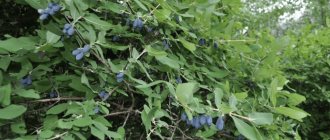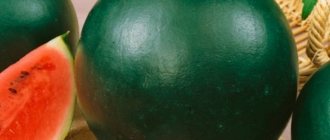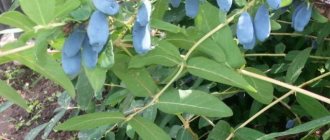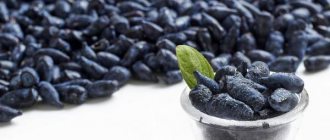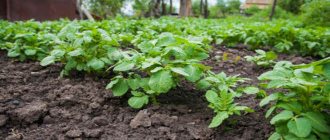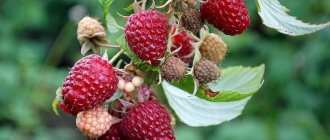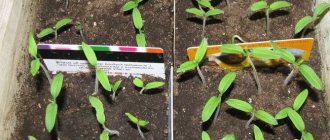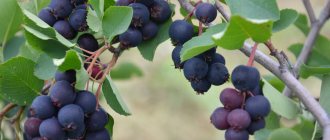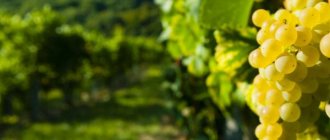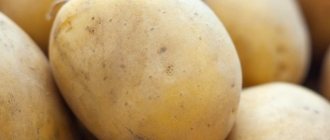Description of the honeysuckle variety
Princess Diana is a domestically selected honeysuckle . The berries are characterized by their large size and pleasant sour-sweet taste. 100 g of fruit contains 14.7% dry matter, 9.3% sugar, 3.4% organic acids, 1.7 mg pectin and 0.15% carotene.
Origin and development
The variety was bred at the end of the 20th century. Russian plant breeder L.P. Kuminov , who, at his own summer cottage in the Moscow region, carried out more than a dozen crossings of wild honeysuckle seedlings from the forests of the Magadan region.
Characteristic
During the flowering period, large white flowers appear on the bushes , arranged in pairs.
The berries are multi-seeded, oblong-oval, large .
They reach 4-5 cm in length, 1–1.2 cm in diameter, weigh 1.5–2.7 g. The surface is slightly lumpy, the skin is thin, of a rich violet-blue color. The pulp is tender, moderately juicy, medium dense . The aroma is weak, the taste is sweet, with a slight sourness, without astringency or bitterness.
Features of application
Princess Diana's berries are suitable for fresh consumption, freezing and canning (preparing jams, juices, preserves).
Reference. After processing, the fruits do not lose their taste and beneficial properties.
Ornamental bushes of this variety of honeysuckle are used in landscape design to decorate gardens and local areas.
Ripening period, yield and fruiting
This is an early ripening variety - the harvest ripens in the second half of June .
The bushes begin to bear fruit 2 years after green cuttings. On average, 4 kg of berries are harvested from a plant.
Resistance to diseases and pests
The crop is susceptible to ramularia, cercospora, powdery mildew, attacks by aphids, mites, scale insects, leaf-eating caterpillars and fingerwings.
Resistance to cold and drought
The bushes can withstand frosts down to -15°C and winter air temperature changes.
The variety prefers moderate moisture . With a lack of moisture, productivity decreases, and excessive watering and waterlogging of the soil lead to rotting of the root system.
Climate requirements
Despite its good resistance to frost and drought, Princess Diana is not suitable for cultivation in the Urals, Siberia and other regions with extreme weather conditions . The variety is suitable for areas with a temperate climate and short frosts.
History of selection
The Princess Diana variety can be called one of the most modern and highly productive assets of the Russian breeding school of recent decades. The selection of this plant was carried out throughout the 90s of the twentieth century by the famous Russian breeder Leonid Petrovich Kuminov. At his own summer cottage, located in the Moscow region, the plant grower carried out several dozen crossings of wild seedlings of the crop, seized from the forests of the Magadan region.
Thanks to the hard work of the breeder, it was possible to obtain a truly unique plant, characterized by unpretentiousness, as well as increased production characteristics. Today, this variety has passed all state tests, after which it was zoned for cultivation in temperate climates.
Advantages and disadvantages of the variety
The main advantages of Princess Diana:
- dessert taste of berries;
- large fruit;
- high productivity;
- ability to adapt to different climatic conditions;
- lack of tendency to shed berries;
- unpretentiousness.
Disadvantages of the variety:
- average degree of frost resistance;
- lack of immunity to a number of diseases and pests;
- need for pollinators.
Differences from other varieties
A comparison of Princess Diana with other early ripening varieties is presented in the table:
Agricultural technology
To successfully grow a crop, it is important to follow a number of rules regarding the selection and preparation of a site, planting bushes and caring for them.
Choosing a place in the garden
To plant Princess Diana, choose an open, well-lit place, protected from gusty winds and drafts , located at least 5 m from any tall plants. The variety is shade-tolerant, but lack of light negatively affects the yield.
Reference. The crop is not grown on black soil, in acidic soil and soils with low moisture capacity.
To eliminate the risk of root rotting due to swampy soil and stagnant moisture, a site is chosen that is not located in a lowland, with a groundwater level of at least 1 m.
Preparing for landing
Suitable for planting are 2-year-old seedlings without signs of pest or disease damage , with intact bark, elastic, moist root system and at least 3 root branches.
Before planting, seedlings are sprayed with a 2% solution of copper sulfate or “Fitosporin”, and the rhizome is soaked for a day in a thick solution of purified clay.
10–15 days before planting, the soil on the site is cleared of weeds, plant debris and other debris.
For every 1 m² of land, add 10 kg of humus, 250 g of crushed charcoal, 100 g of superphosphate and 25 g of potassium nitrate. The soil is dug up 30 cm deep and leveled.
Characteristic
This variety of honeysuckle is a typical representative of this fruit crop. But, despite this, the plant has a whole complex of various qualities, ensuring its uniqueness and belonging to a separate variety. These include special characteristics of harvest and fruiting, as well as resistance to a variety of negative weather conditions.
Frost resistance and drought resistance
Princess Diana in the recommended growing area is considered a fairly drought and frost tolerant species. However, this feature does not allow the bush to be grown in the Urals, Siberia and other geographical areas with extreme weather conditions. It is cultivated only in temperate climates with mild weather conditions and short frosts.
Photo gallery: varieties of Japanese honeysuckle
Japanese honeysuckle
Honeysuckle is represented in Russian gardens by several varieties, the care for which does not differ significantly:
- mulch and shade the root part;
- carry out thinning pruning every 2–3 years; it is carried out in the spring, when the buds wake up;
- perform formative pruning - the annual growth of shoots by 1.5–2 m can very soon turn the plant into a tangle of chaotically intertwined branches, of course, if this is not an artistic idea;
- fixation to any type of support, if the vine is not assigned a ground cover function;
- shelter for the winter in harsh climates (on supports or lashes laid on the ground).
Halliana Lonicera japonica Halliana
Liana Halliana pleases the eye all year round - from autumn to summer with lush greenery (belongs to the semi-evergreen or evergreen species), and from June to October - with lush fragrant flowers. Honeysuckle grows up to 6 m in length with an annual growth of 1.5 m; has large leaves, pubescent at a tender age. The main advantage of Halliana is its flowers, which are considered one of the most fragrant. The sight of blooming Halliana is amazing - clusters of huge flowers with a diameter of 8–10 cm, bloom daily and gradually change their color as they fade from snow-white to honey-yellow. Flowering occurs on the shoots of the current year. The plant tolerates partial shade and poor soil. Despite frost resistance (up to -34 o C), the root part, root collar and shoots need shelter, which, however, are quickly restored if they freeze. It is noteworthy that in the conditions of northern Ukraine (Kyiv), northeastern Belarus (Vitebsk), Estonia, and also in Vladivostok, honeysuckle blooms infrequently.
Aureoreticulata
The liana is up to 3–4 m long, unpredictable in terms of flowering (it may or may not bloom), but this does not in any way affect its decorative value. The liana is attractive with its leaves, made by Mother Nature using the craquelure technique, where every “crack” is filled with gold. That is why the second name of Aureoreticulata is golden reticulate. It is used for vertical gardening both in open ground and on verandas and balconies. Overwinters without shelter only in regions with warm and temperate climates; prefers illuminated places.
Variegated (Sherlite)
This variety of honeysuckle is beautiful no matter how you look at it - the leaves are bordered by an uneven stripe of creamy color, the fragrant flowers are pastel crimson on the outside and milky white on the inside. Considering the length of the main vine (up to 10 m or more), as well as to maintain decorativeness, the plant should be pruned annually. Last year's shoots are shortened by 30 cm, giving them the opportunity to branch, and flowers form on the young growth. Sherlite prefers sunny places.
Photo of bush and berries
In the photo of the honeysuckle variety you can see that it is a medium-sized shrub. It has a reverse-conical crown. Its base is straight grayish-brown branches. There is no pubescence on the outer covers of the shoots. Their location in the crown is uniform. Therefore, it is characterized by moderate or medium thickening.
We recommend that you familiarize yourself with Honeysuckle Morena
Each shoot has large lanceolate leaves. They are colored bright green and without pubescence. When flowering, the shrub is strewn with large white flowers, arranged in pairs in the corners of the leaf blades.
The dark blue berry is oblong-oval. It has a cylindrical structure. The skin of a large fruit is covered with small single tubercles.
Photo gallery: the beauty of ripe honeysuckle
Honeysuckle Serotina (Lonicera periclymenum Serotina)
It is a liana that can climb supports to a height of 4 m. It has a record annual growth of up to 1 m. Among other varieties, the liana has the longest flowering period - from June - August to September. If you take the trouble and regularly remove faded inflorescences, flowering will last much longer. A pronounced aroma, identical to linden, intensifies in the evening. Fruit formations - cones, are several fused berries that ripen in July - October. In central Russia, the vine is covered for the winter, for which it is removed from its supports.
Botanical description
Princess Diana is a compact, medium-sized bush, characterized by an obverse-conical crown shape. Its basis is straight shoots of gray-brown color; there is no pubescence on the surface of the outer covers of the branches. The branches are located evenly in the crown, thanks to which it develops of moderate or medium density. The average length of the plant reaches 1.9 m.
Each shoot is covered with large lanceolate leaves of a rich green color; there is no pubescence on the leaves. During flowering, the bush is covered with rather large white flowers, located in pairs in the corners of the leaves. The fruit of the variety is a multi-seeded berry with an oblong-oval shape and a cylindrical structure.
Did you know? Honeysuckle was described and systematized in the middle of the 18th century. the legendary Swedish botanist and naturalist Carl Linnaeus.
The color of the berries is rich, dark blue, the surface of the peel is covered with small single tubercles. The pulp of the fruit is moderately juicy, dense, of medium consistency. The taste of the harvest is rich, sweet, with a slight sourness, the aroma is not pronounced, and bitterness is not inherent in the berries.
Photo gallery: decorative honeysuckle in landscape design
Honeysuckle (Lonicera pileata)
Shapochnaya honeysuckle is tipped to serve as a substitute for boxwood, which is not surprising, taking into account their amazing external similarity. The evergreen variety grows as a bush with a height of 0.8–1.3 m and a habit diameter of 1.5 to 2 m. The bush tolerates pruning well, so its natural slightly “shaggy” appearance is easily transformed into civil balls and parallelepipeds. The cream flowers are small (5 mm long), inconspicuous, but fragrant; flowering occurs in May. The berries ripen infrequently. Several reasons why you should plant Honeysuckle Cap is worth planting, if only because it:
- survives in urban conditions, which means dust, gas pollution, occasional watering;
- tolerates the immediate vicinity of other root systems;
- grows on any soil;
- it is convenient to cover it with snow or spunbond for the winter;
- easily propagated by layering.
Health Benefits of Honeysuckle
Modern varieties of honeysuckle are very tasty and very healthy. Without exaggeration, we can say that one honeysuckle berry contains a whole pharmacy. They gently and for a long time lower blood pressure, normalize the functioning of the gastrointestinal tract and liver. Edible honeysuckle has high hematopoietic abilities. It also contains a lot of potassium and magnesium, which is useful in the treatment of heart diseases.
Honeysuckle is a high-vitamin crop. Among berries growing in temperate climates, it has the highest level of C-P activity: a very high and ideally proportioned combination of vitamins C and P, which are not stable without each other and are not absorbed by the human body.
Research in recent years has discovered that honeysuckle berries contain substances that can remove heavy metals, including radionuclides, from the body. Honeysuckle is the record holder among berries for the content of the important amino acid tryptophan. From this amino acid, the human body synthesizes the “good mood hormone” - serotonin. Therefore, consuming honeysuckle berries and processed products from it has a positive effect on mental health.
Edible honeysuckle
Honeysuckle is characterized by exceptional winter hardiness - it can withstand frosts of 50 degrees, the flowers easily tolerate return frosts down to -7 o C and even a short-term drop in temperature to -13 o C. The culture is completely unpretentious and can easily grow and bear fruit for several years without human intervention. Caring for bushes cannot be called burdensome - it comes down to pruning dry and improperly growing branches, weeding and watering. Honeysuckle begins to bear fruit 3–4 years after planting and propagates by rooting layering and cuttings, which allows preserving varietal characteristics. The shape of the berries is slightly “sloppy”; the taste is reminiscent of blueberries.
When choosing a variety, first of all, pay attention to the ripening time, the size and taste of the berries, how easily they fall off, yield and, most importantly, whether the selected variety is suitable for this region. It is recommended to pay attention to the characteristics of the breeding group, because no matter how resistant the plant may be, it is the zoned varieties that are best adapted to local weather “tricks”.
Ripening time
The first honeysuckle berries in all respects appear at the end of May. From mid-June until the end of the month, they release the harvest, varieties of all fruiting periods.
Super early
Flowering in March-April, ripening at the end of May:
- Wojtek - powerful bushes up to 1.6 m tall; the yield reaches 2–6 kg per bush, the berries are narrowly oval in shape and covered with a bluish coating;
- Sorceress is a slightly spreading bush up to 1.5 m high; the berries look like jugs with a bumpy surface; the taste is refreshing, intended for processing;
- Duet - bush height up to 1 m, berry weight 1.3 g, taste slightly bitter; the variety is drought-resistant;
- Sineglazka - medium-sized berries weighing up to 1 g, aromatic, sweet and sour taste, universal purpose; the variety is resistant to spotting;
- Vitamin - medium-sized bush up to 1.3 m, yield up to 1.3 kg per bush; small berry - 0.7 g, sweet; cylindrical shape.
Early maturing
Varieties that ripen between June 12 and June 16:
- Amur is a tall bush up to 2 m with luxurious forms and no less luxurious berries up to 2.5 cm long and up to 8 mm in diameter. On average, up to 4 kg of berries are obtained from the bush;
- Atut - characterized by long, fragrant flowering. The fruits are large - length up to 3 cm, weight on average 1 g; have a high content of vitamin C; universal purpose;
- Princess - begins to bear fruit from the age of 5–6, the yield ranges from 1.7–2.4 kg per bush . The average weight of the berries reaches 1.4 g, the pulp is juicy. A feature of the variety is its stable state of dormancy in the fall - there is no re-blooming;
- Bogucharskaya - the variety is undemanding to the soil, but loves lighted places. The berries resemble elongated barrels, weigh on average 0.8 g, and there is no bitterness in the taste. Each bush produces up to 4.5 kg of product.
Mid-season
The wave of first delight from the early berry subsides, which is replaced by mid-season honeysuckle. The teeth are set on edge, and the people, having received a portion of vitamins, have the opportunity to calmly get down to winter berry preparations. During the period from June 17 to June 22, the variety ripens:
- The young lady is quite a compact bush with average yields - from 2 to 2.3 kg per bush, with a berry weight of 1 g; the berries are sweet and sour, similar to a cylinder;
- Balalaika - begins to bear fruit in 2–3 years, the fruits are light blue, large; shape - a cylinder with a characteristic ridge. Characterized by stable fruiting, gives good performance on cultivated soils with good lighting;
- Borealis is a spreading bush with an average yield of 4.5 kg. Juicy berries with a sweet and sour, slightly astringent taste are, among other things, used for making juice. The variety is disease resistant;
- Moskovskaya 23 is a spreading bush with medium ripening period. The berries have average parameters: weight 0.75 g, length 1.9 cm, diameter 1 cm. The pulp is somewhat fibrous, which is compensated by the increased content of ascorbic acid and the predominance of sweetness in the taste. The surface of the berry is uneven - folds and bumps; does not crumble for a long time;
- Rebecca (Canadian selection) - low bushes, yield up to 2–2.5 kg each; the berries are distinguished by their hard but fragile skin and remarkable sweetness;
- Slastena is a low-growing bush with berries of excellent properties - thick skin, strong aroma and dessert taste. The variety is heat and drought resistant;
- Shahinya is a medium-spreading bush with thick red-brown shoots. The berries are not bitter and smell pleasant; average weight 1.1 g; stay on the branch for a long time. An average of 2 kg is removed from a bush. Drought resistance is average.
New generation honeysuckle
In the central zone, almost every gardener has two or three honeysuckle bushes. But they get very little fruit. This is because they grow varieties of the old generation - Blue Spindle, Blue Bird, Start, Kamchadalka. They bear fruit intermittently, their fruits are small, and even those fall off. In addition, the berries have a mediocre taste - not for everyone.
Meanwhile, you can now find the latest varieties on sale, which have serious requirements - they must be:
• large-fruited, that is, the berry is at least 1 g;
• tastes like dessert – tasting score of at least 4 points;
• productive, that is, at least 2 kg per bush;
• without autumn flowering;
• dry tear-off, uniform fruits, without bumps or irregularities.
Such varieties already exist. Thus, in 2005, a new variety, Blue Dessert, was submitted for variety testing. And he is not alone, there is also Antoshka, Princess Diana, Dolphin, Viliga, Viola and others.
If the main thing for you is the highest yield, then stop collecting two or three cups per bush and plant the varieties Princess Diana, Antoshka, Baryshnya, Princess, Canning, Pamyati Kuminova, Dolphin, Nymph, Gzhelka, Gzhelskaya rannyaya, Kucha mala.
If the main thing for you is early fruiting, then in the first year you can get a harvest from bushes of the Bakcharsky Giant, Bakcharskaya Yubileinyaya, Silginka, Lenarola, Masha, and Souvenir varieties.
Honeysuckle is the earliest berry in the garden. It ripens in mid-May. This is very important, since more than 50% of the honeysuckle harvest is consumed fresh. But if you need preparations for the winter or want to stretch out the fruit harvest, plant varieties that ripen in June-July; they already exist.
Most often in markets people ask about varieties with large berries that lack bitterness. These are Dolphin, Nymph, Viliga, Nakhodka, Princess Diana, Princess, In Memory of Kuminov, Polivan, Birdie, Dark Night, Three Friends, Bakcharsky Giant, Silginka, Chulymskaya, Leningrad Giant, Malvina, Morena.
Apparently, the time is not far off when honeysuckle will again become a very popular berry. Not only among supporters of a healthy lifestyle, but also among ordinary gardeners.
yard.hozvo.ru
Honeysuckle 2021
Moderators: Vital, Roman S.
- Go to page:
Messages: 375 Registered: 10/19/2016, 03:31 Interests: honeysuckle, blackberry From: Bavaria, Augsburg Thanked: 853 times Thanked: 424 times
Status: Offline
Honeysuckle 2018
Posted by Bavarian » 01/02/2018, 01:10
Discussion of other seasons:
Messages: 2848 Registered: 09/25/2009, 01:49 From: Moscow, dacha north Moscow Region Thanked: 2600 times Thanked: 1328 times
Status: Offline
Honeysuckle: expert advice
Message from KryzIr » 01/02/2018, 02:02
Messages: 502 Registered: 08/20/2016, 14:58 From: Moscow. dacha in Balabanovo Kaluzh. region Thanked: 248 times Thanked: 344 times
Status: Offline
Honeysuckle: expert advice
Message from Pavel summer resident » 01/02/2018, 15:17
Messages: 3869 Registered: 04/12/2010, 09:43 From: Far beyond S. Posad, Lefortovo Thanked: 1149 times Thanked: 2585 times
Status: Offline
Honeysuckle: expert advice
Message from Nyur » 01/02/2018, 15:28
Messages: 592 Registered: 01/07/2017, 13:53 From: Mikhailov, Ryazan region. Thanked: 520 times Thanked: 553 times
Status: Offline
Honeysuckle: expert advice
Message from Peter » 01/02/2018, 16:00
Messages: 375 Registered: 10/19/2016, 03:31 Interests: honeysuckle, blackberry From: Bavaria, Augsburg Thanked: 853 times Thanked: 424 times
Status: Offline
Honeysuckle: expert advice
Posted by Bavarian » 01/02/2018, 16:52
Messages: 880 Registered: 10/22/2012, 04:35 pm Interests: gardening, forest, fishing Occupation: Orthodox theology and religious studies, medicine From: Moscow and Taldomsky district of Moscow Region Thanked: 468 times Thanked: 574 times
Status: Offline
Honeysuckle: expert advice
Message from Hare » 01/03/2018, 07:56
Messages: 502 Registered: 08/20/2016, 14:58 From: Moscow. dacha in Balabanovo Kaluzh. region Thanked: 248 times Thanked: 344 times
Status: Offline
Honeysuckle: expert advice
Message from Pavel summer resident » 01/03/2018, 11:40
Messages: 560 Registered: 12/20/2014, 00:27 Occupation: pensioner From: Dacha South, Taldom district, Moscow region. Thanked: 210 times Thanked: 650 times
Status: Offline
Honeysuckle: expert advice
Posted by bodge » 01/03/2018, 13:01
Messages: 592 Registered: 01/07/2017, 13:53 From: Mikhailov, Ryazan region. Thanked: 520 times Thanked: 553 times
Status: Offline
Honeysuckle: expert advice
Message from Peter » 01/03/2018, 13:42
Messages: 68 Registered: 09/11/2011, 18:03 Occupation: pensioner From: Istra, Moscow region Thanked: 130 times Thanked: 64 times
Status: Offline
Honeysuckle: expert advice
Posted by Valentin » 01/03/2018, 14:23
Messages: 560 Registered: 12/20/2014, 00:27 Occupation: pensioner From: Dacha South, Taldom district, Moscow region. Thanked: 210 times Thanked: 650 times
Status: Offline
Honeysuckle: expert advice
Posted by bodge » 01/03/2018, 14:57
Messages: 375 Registered: 10/19/2016, 03:31 Interests: honeysuckle, blackberry From: Bavaria, Augsburg Thanked: 853 times Thanked: 424 times
Status: Offline
Honeysuckle: expert advice
Posted by Bavarian » 01/04/2018, 02:39
Messages: 275 Registered: 10/20/2015, 03:59 From: Khabarovsk Thanked: 122 times Thanked: 142 times
Status: Offline
Honeysuckle: expert advice
Message from Vlad dv » 01/04/2018, 16:54
Messages: 592 Registered: 01/07/2017, 13:53 From: Mikhailov, Ryazan region. Thanked: 520 times Thanked: 553 times
Status: Offline
